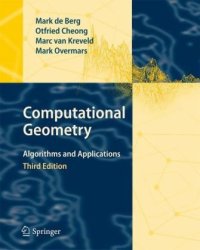
Ebook: Computational geometry: algorithms and applications
Author: Prof. Dr. Mark de Berg Dr. Otfried Cheong Dr. Marc van Kreveld Prof. Dr. Mark Overmars (auth.)
- Genre: Mathematics // Geometry and Topology
- Tags: Math Applications in Computer Science, Computer Applications in Geosciences, Computer Graphics, Geometry, Algorithm Analysis and Problem Complexity, Systems and Information Theory in Engineering
- Year: 2008
- Publisher: Springer-Verlag Berlin Heidelberg
- Edition: 3
- Language: English
- pdf
Computational geometry emerged from the ?eld of algorithms design and analysis in the late 1970s. It has grown into a recognized discipline with its own journals, conferences, and a large community of active researchers. The success of the ?eld as a research discipline can on the one hand be explained from the beauty of the problems studied and the solutions obtained, and, on the other hand, by the many application domains—computer graphics, geographic information systems (GIS), robotics, and others—in which geometric algorithms play a fundamental role. For many geometric problems the early algorithmic solutions were either slow or dif?cult to understand and implement. In recent years a number of new algorithmic techniques have been developed that improved and simpli?ed many of the previous approaches. In this textbook we have tried to make these modern algorithmic solutions accessible to a large audience. The book has been written as a textbook for a course in computational geometry, but it can also be used for self-study.
This well-accepted introduction to computational geometry is a textbook for high-level undergraduate and low-level graduate courses. The focus is on algorithms and hence the book is well suited for students in computer science and engineering. Motivation is provided from the application areas: all solutions and techniques from computational geometry are related to particular applications in robotics, graphics, CAD/CAM, and geographic information systems. For students this motivation will be especially welcome. Modern insights in computational geometry are used to provide solutions that are both efficient and easy to understand and implement. All the basic techniques and topics from computational geometry, as well as several more advanced topics, are covered. The book is largely self-contained and can be used for self-study by anyone with a basic background in algorithms.
In this third edition, besides revisions to the second edition, new sections discussing Voronoi diagrams of line segments, farthest-point Voronoi diagrams, and realistic input models have been added.